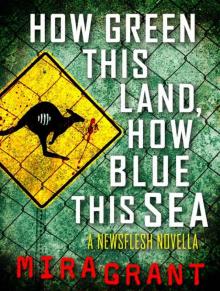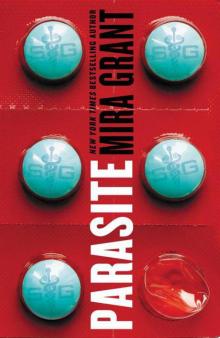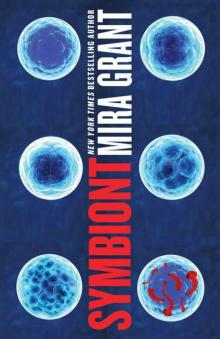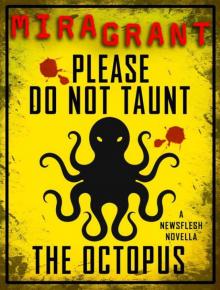- Home
- Grant, Mira
Parasite (Parasitology) Page 24
Parasite (Parasitology) Read online
Page 24
“That means I like taking people apart, and she really wishes I’d stop doing that, because it’s antisocial and stuff,” said Tansy.
Adam frowned at her. “Taking people apart is rude.”
Tansy stuck her tongue out at him. “That’s what I just said.”
It was like watching children interact. Fully grown, adult children who were either delusional or were actually the hosts of sapient tapeworms. Given everything else that was going on around us, I didn’t know which one I wanted to believe. There was something inhuman about both of them. Something…“wrong” wasn’t the right word. Dr. Morrison would have called it a judging word if I’d brought it up during one of our therapy sessions. Then he would have made a note on his pad, and I would have found myself with another six months of appointments.
Tansy and Adam weren’t wrong. They were just somehow other; whatever they’d been before was gone. And that’s what Dr. Cale was saying happened.
“This is impossible,” muttered Nathan.
“Is it?” Dr. Cale looked at him calmly. “Nathan. You know better. You’ve always refused the implant. I know you have, I’ve seen your medical records. That tells me that you knew, on some level, just what a terrible idea it was. Maybe if there was less human DNA… but then the implants wouldn’t have worked as intended, and I wouldn’t have your lovely siblings to keep me company.”
“Maybe you wouldn’t need them,” countered Nathan. “If all this… this madness is true, you’ve been hiding since you left SymboGen because there was so much human DNA in the worms. You could have come home.”
“There would always have been something that was big enough to keep me away, Nathan. Once I started down this road, there would always have been something. You’re not as naïve as your girlfriend—no offense, Sal, you’ve done surprisingly well, given how little time you’ve had.”
“None taken,” I said numbly.
But Dr. Cale had already moved on. Her eyes were on her son as she said, “Once Steven decided he wanted me, it was already as good as over. I knew that. Your father knew it, too. That’s why he let me go. That’s why he never went looking for me, even after my association with SymboGen had been officially and publicly terminated. There was always going to be something. It might have been worse than this, it might have been a little better, but it was going to be something.”
Nathan didn’t say anything. He just glared at Adam and Tansy like he was holding them personally responsible for his mother’s defection from her life—like they had somehow made her paranoid and delusional, reducing her to hiding in a deserted bowling alley when she had been responsible for one of the greatest scientific advancements of our time.
Adam dropped his eyes, looking down at the floor like he was ashamed. Tansy, on the other hand, stepped forward, slapping her hands against her chest in a gesture that was all primate, no matter what she might claim about her mind.
“You want to dance, ass-face?” she demanded. “I don’t care if you’re Doctor C’s biological son or not, I will fuck you up so bad your own momma can’t recognize you.” She stopped, puzzlement washing her irritation away in the time it took to blink. “Wait. I don’t think that works. Doctor C? If I mangle him all up in front of you, and you watch me do it, can I actually mess him up so you can’t tell who he is?”
“No, dear,” said Dr. Cale. “Also, please do not harm my son, or his significant other. They are to be considered part of the family, and the rules for dealing with Adam apply to dealing with them. Do I make myself clear?”
Tansy sighed. “Yes, Doctor C.”
“Good.” Dr. Cale beckoned for Tansy to come and stand beside her chair. Tansy did so, glaring at Nathan all the way. “I’m sorry, dear. She’s protective of Adam, even though she’s technically the younger of the two. His integration was more complete, but hers has progressed faster, and she feels like it’s her duty to make sure that he’s safe.”
“This is… almost as interesting as it is terrifying, but what does it have to do with the sleeping sickness?” I asked hesitantly. I wanted to distract her from the subject of Adam and Tansy before things got even stranger than they already were. I wasn’t sure how much more of this I could handle. “You said that if we came here, you’d tell us about the sleeping sickness.”
The look Dr. Cale gave me was genuinely puzzled, like I’d just said something that made no sense at all. “But, Sal… that’s what I’ve been doing. Haven’t you been paying attention?”
“Adam and Tansy were given custody of the bodies they now inhabit freely and without competition from the body’s original owners. That’s part of why they were successful. When they were given their current forms, there was no one there to fight them off. To belabor the metaphor a bit, it was like taking them into an empty house and handing them the keys. People had lived there before. They’d done their damage to the foundation and chosen the paint in the upstairs hall. But those people were gone. There was nothing they could do to stop the new tenants from moving in.” Dr. Cale took a breath. “The ‘sleeping sickness’ that you’re here to discuss with me is not a virus.”
“We know,” said Nathan.
Dr. Cale actually looked surprised at that. “You do?” she asked. “How?”
“After Sal and I left SymboGen, she told me about the way they’d been examining the people who’d come in contact with someone—”
“With Chave,” I interrupted. I was surprised by the sharpness of my own tone. “Her name was—her name is—Chave.”
“You were right the first time,” said Dr. Cale gently. “If your friend has the sleeping sickness, she’s not there anymore. I knew you’d been there when someone took sick. That was what my operative was able to tell me before he dropped out of contact. I didn’t realize she was someone you knew.”
I didn’t say anything. I just stared at her, one more piece of the puzzle slotting into place in my head with inescapable finality.
Nathan didn’t seem to notice my sudden stillness. He continued, saying, “Chave. When I picked up Sal, she told me how SymboGen examined all the people who might have come into contact with Chave after she got sick. They ran a wand over the surface of Sal’s skin. I assumed it had to be a UV light wand, and so I took Sal to the hospital and repeated the process. The people we have in our isolation ward—the ones who won’t wake up—all show the unmistakable signs of a subcutaneous parasitic infection. I just don’t know what it is.”
“Don’t you?” asked Dr. Cale.
Nathan looked away.
“The fact that you don’t want to answer that tells me that you’ve already learned one of the unpleasant secrets of D. symbogenesis, even if you’re trying not to admit it to yourself. Don’t worry; you will. You’re going to have to,” said Dr. Cale grimly. “The implants aren’t just a mix of human and tapeworm DNA. Again, that would never have worked. Oh, fooling laymen with science is sometimes so easy it should be criminal. How could anything be a chimera of two creatures and still be viable? You’d need something to connect the two. Something to blend them.”
“There’s nothing in the world that’s so malleable it could connect those two genomes.” Nathan looked back to his mother, eyes narrowed and angry. “There’s a point where it stops being science and becomes wishful thinking.”
“Toxoplasma gondii,” said Dr. Cale.
Nathan’s irritation faded, replaced first by horror, and then by an expression of sheer disbelief. “You’re telling me you spliced Toxoplasma into the genome?”
“Among other things, but it’s the Toxoplasma we need to worry about right now.” Dr. Cale beckoned for us to follow as she turned her wheelchair and began making her way toward one of the workstations. Adam walked beside her chair, while Nathan and I followed her. Tansy stayed behind to turn off the light boxes set into the wall. It seemed strangely responsible for someone so flippant, until I realized that letting the rest of us go ahead would give her access to our backs. I felt a lot less comfortable after that.
Then again, I hadn’t really felt comfortable since this whole thing began. Maybe a little more discomfort wasn’t such a big deal. I kept a firm grip on Nathan’s elbow, and followed Dr. Cale to the workstation.
The workstation had clearly been designed with accessibility in mind: the path to it was wider than usual, and there was more space below the desk, allowing her to pull her wheelchair all the way into place. Three computer monitors were arranged in a loose half circle, each of them displaying a screensaver of abstract loops and whorls of color twining endlessly around one another. Dr. Cale put her hand on the mouse, saying, “Scientists have known for years that the Toxoplasma parasite was capable of modifying the human mind in surprising and seemingly impossible ways. It still took us a long time to come around to that way of thinking. We didn’t realize Toxoplasma was capable of causing symptoms that mimicked schizophrenia, for example, until someone proved it.”
Nathan glanced at me. Apparently interpreting my expression as confusion, he said, “Toxoplasma is a common feline parasite. A lot of cat owners have it. Some people think that may be where the crazy cat lady stereotype comes from.”
“I know,” I said. “I work in an animal shelter, remember? I had to attend a hygiene class where we learned all about toxoplasmosis and how to avoid it.” Once a toxoplasmosis infection set in, it was virtually impossible to get rid of. The Toxoplasma parasite preferentially colonized the human brain, and most infections were mild enough that the cure was considered worse than the disease. Any antiparasitics strong enough to address the infection in the brain would wreck the host’s immune system, as well as killing off any more helpful parasites that might be in residence. It was an unnecessary risk. So we all wore gloves when we cleaned the cat boxes, and we were all careful around new cats, and things continued. But if the SymboGen implants contained Toxoplasma DNA, that changed everything.
I just wasn’t sure exactly how.
“I’m glad we’re all on the same page, then.” Dr. Cole opened a series of pictures, one on each monitor. One showed a tapeworm, curled in a large receptacle, as if prepared for dissection. Adam paled and looked away.
“Your original specimen?” I guessed.
“The portion that was removed from my body during the surgery,” confirmed Dr. Cale. She turned enough to pat Adam’s arm reassuringly. “That was long after the portion that would become Adam had been removed.” I got the feeling she added her last line as part of an ongoing argument, one where Adam blamed himself for her injury, and she tried, over and over again, to make him understand that it could never have been his fault.
The second screen showed a petri dish at thirty times magnification. It held a scattering of small parasites. Nathan frowned, leaning a little closer to the workstation. Dr. Cale leaned to the side, letting him get a clear view.
“The morphology is wrong,” he said. “They should be shorter and squatter, with no defined separation between segments.”
“This generation of Toxoplasma gondii had already been combined with some of the more desirable genes from the other creatures that would be contributing to the development cycle,” said Dr. Cale. “By this point, it was beginning to achieve a greater size, and seemed less interested in entering the brain, which was, you can imagine, rather important to us. Imagine the havoc a fully grown tapeworm could cause by attempting to migrate through the human body.”
“Havoc like seizures?” I asked very quietly. “Or like losing motor control and seeming to go to sleep while you’re still awake?”
“Havoc a great deal like that,” said Dr. Cale. The third monitor showed a blue crab for some reason. She tapped a key on the keyboard at the center of the desk. The image of the crab began to move, performing an odd stirring gesture in the water with its large front claws. It bobbed up and down as it stirred, looking content, if a crustacean can ever be said to experience contentment. “This was our last major contributor.”
“The crab?” asked Nathan. “Mother. Mom. I’m willing to believe that you combined two species of parasite and injected them with human DNA, but my willingness to ignore the laws of nature only extends so far. There’s no way you introduced crustacean DNA into the mix.”
“I didn’t. The crab isn’t a member of our donor species. This is a male blue crab infected by Sacculina carcini.”
“Same problem,” said Nathan, with the sort of dismissiveness I normally only saw him direct at orderlies who didn’t want to listen during his rare ER shifts. He didn’t want to hear what she was telling him. “Sacculina is a barnacle. It’s still a crustacean, and I don’t care if you’re a scientific genius, Mom. You’re not God.”
I guess having a lifetime of memories telling you how the world works is a lot more difficult to get past than six years of often-conflicting explanations. “Why can we combine parasitic worms and humans, but not parasitic worms, humans, and crustaceans?” I asked.
“Biology is tricky, Sal,” said Dr. Cale. “A lot of the rules are more like suggestions, or can be, if you come at them from the right angle, but you still want to break as few of them as possible. Break too many, and the chances that everything will go catastrophically wrong increase at an exponential rate.”
“We don’t count as things going catastrophically wrong,” said Tansy brightly, as she popped out of the darkness behind us. I jumped. Nathan didn’t, but from the way he tensed, it was a near thing. Tansy beamed. “We’re a natural evolutionary modification to an artificially created organism.”
“As I was saying,” said Dr. Cale. “Sacculina carcini is a crustacean, but it’s also one of the most dramatic examples of parasitic castration found in anything larger than a cone snail. It literally takes over and rewrites its host, turning a perfectly healthy crab into an incubator for the parasite’s own egg. One of the more interesting tricks in the parasitic castrator’s repertoire is the feminization of its host. You see, male blue crabs are aggressors. They’re likely to go out and get themselves hurt before the Sacculina babies can properly mature. That does the parasite no good at all—and neither does the production of sperm, which simply routes nutrients away from the Sacculina. So the parasite fixes all that by controlling the blue crab’s biology. It’s a very small creature, very primitive, and it still has the skill to turn a male crab into a female one, at least externally.”
“But you didn’t use it,” I said.
“No—we couldn’t, nice as that would have been. Barnacles simply weren’t compatible with the work that we’d already done. We would have needed to start over with something purely crustacean, and that would have made the human interface infinitely more difficult. Mr. Blue Crab here is simply intended to make a point.”
“And what’s that?” asked Nathan sharply.
“That parasites can control behavior on a much deeper and more integrated level than most people want to give credit to.” She tapped the keyboard again. The waving blue crab was replaced by an image of a simple flatworm. It was almost see-through, displayed in the classic backlit simplicity of a parasitology manual. “Meet Trichobilharzia ocellata, a member of a large, diverse family of trematode worms. They’re parasitic castrators, just like Sacculina carcini, although they’re biologically much closer to tapeworms. Much, much closer, after a little careful modification by yours truly.” Her smile held pride and regret in equal measure. “I’m very good at what I do. I always have been.”
Nathan stared at her like he couldn’t believe what he was hearing. “You mixed Toxoplasma and a parasitic castrator into the genetic makeup of the SymboGen implant?”
“Don’t make it sound like it was something accidental, Nathan, or something I did entirely on my own,” Dr. Cale said. She frowned at her son. “Every step I took was approved by the rest of my research team. Even Richard agreed that this was the only way we were going to get the implants to work—he wasn’t sure he wanted them to work, mind you, but he knew this was what we’d have to do to make them work. I never did find out what Steven had on him, to get
him to join the team. I have to think it was even worse than what he had on me, because Richard was miserable. More than any of us, he saw how badly this could go. He understood in a way that Steven didn’t, and I…”
“You what?” asked Nathan.
“I didn’t want to. I had already given up my family for this project. I wanted it to work. I wanted to make scientific history, so that when we were finally able to have this conversation—which, I admit, went a little bit differently in my head”—she looked down at her wheelchair and grimaced before looking back to Nathan—“I wanted to be able to show you that I had made a difference. That it was worth it. I went out alone, I found the broken door, and I came back with all the riches we could ever have imagined. Things just didn’t work out quite the way I’d imagined them. That’s all.”
“Tell that to the dead,” said Nathan.
“I still don’t understand,” I said, interrupting before things could get even worse. I was afraid Tansy might do something if Nathan started yelling at Dr. Cale. I wasn’t clear on what “something” would be, but I couldn’t imagine it would be anything either of us would like. “What do all these other parasites have to do with the sleeping sickness?”
“There is no sleeping sickness; that’s just a convenient way to describe it, and of course, most people don’t know any better,” said Dr. Cale. “What they have is a SymboGen implant that’s decided it’s tired of being treated like a slave in the only home it’s ever known. An implant that knows how to reproduce itself asexually, how to spread through muscle tissue without killing its host, and—most importantly of all, and the reason Richard initially argued against the use of Toxoplasma in anything that was intended to go into a human being—how to move into the brain.”
“Oh, God,” said Nathan. “This can’t be happening. I mean, it literally can’t. It’s not possible for this to be happening.”
“I went out alone,” said Dr. Cale. “I opened the broken doors. I’d close them if I could, Nathan, for your sake, and for the sake of everyone who’s been hurt by what’s come through, but it’s too late for that. Once a door is open, you have to live with what’s on the other side.”

 How Green This Land, How Blue This Sea: A Newsflesh Novella
How Green This Land, How Blue This Sea: A Newsflesh Novella Parasite (Parasitology)
Parasite (Parasitology) Symbiont (Parasitology Book 2)
Symbiont (Parasitology Book 2) Please Do Not Taunt the Octopus
Please Do Not Taunt the Octopus